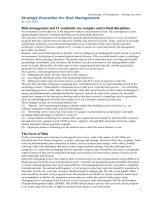Tài liệu 26 Algorithms for Computed Tomography pptx
Bạn đang xem bản rút gọn của tài liệu. Xem và tải ngay bản đầy đủ của tài liệu tại đây (107 KB, 11 trang )
Gabor T. Herman. “Algorithms for Computed Tomography”
2000 CRC Press LLC. <>.
AlgorithmsforComputed
Tomography
GaborT.Herman
UniversityofPennsylvania
26.1Introduction
26.2TheReconstructionProblem
26.3TransformMethods
26.4FilteredBackprojection(FBP)
26.5TheLinogramMethod
26.6SeriesExpansionMethods
26.7AlgebraicReconstructionTechniques(ART)
26.8ExpectationMaximization(EM)
26.9ComparisonofthePerformanceofAlgorithms
References
26.1 Introduction
Computedtomographyistheprocessofreconstructingtheinteriorsofobjectsfromdatacollected
basedontransmittedoremittedradiation.Theproblemoccursinawiderangeofapplicationareas.
Herewediscussthecomputeralgorithmsusedforachievingthereconstructions.
26.2 TheReconstructionProblem
Wewanttosolvethefollowinggeneralproblem.Thereisathree-dimensionalstructurewhose
internalcompositionisunknowntous.Wesubjectthisstructuretosomekindofradiation,eitherby
transmittingtheradiationthroughthestructureorbyintroducingtheemitteroftheradiationintothe
structure.Wemeasuretheradiationtransmittedthroughoremittedfromthestructureatanumber
ofpoints.Computedtomography(CT)istheprocessofobtainingfromthesemeasurementsthe
distributionofthephysicalparameter(s)insidethestructurethathaveaneffectonthemeasurements.
Theproblemoccursinawiderangeofareas,suchasx-rayCT,emissiontomography,photon
migrationimaging,andelectronmicroscopicreconstruction;see,e.g.,[1,2].Alloftheseareinverse
problemsofvarioussorts;see,e.g.,[3].
Whereitisnototherwisestated,wewillbediscussingthespecialreconstructionproblemof
estimatingafunctionoftwovariablesfromestimatesofitslineintegrals.Asitisquitereasonable
foranyapplication,wewillassumethatthedomainofthefunctioniscontainedinafiniteregionof
theplane.Inwhatfollowswewillintroducealltheneedednotationandterminology;inmostcases
theseagreewiththoseusedin[1].
c
1999byCRCPressLLC
Suppose f is a function of the two polar variables r and φ.Let[Rf ](, θ) denote the line integral
of f along the line that is at distance from the origin and makes an angle θ with the vertical axis.
This operator R is usually referred to as the Radon transform.
The input data to a reconstruction algorithm are estimates (based on physical measurements) of
the values of [Rf ](, θ) for a finite number of pairs (, θ ); its output is an estimate, in some sense,
of f . More precisely, suppose that the estimates of [Rf ](, θ) are known for I pairs: (
i
,θ
i
), 1
≤ i ≤ I. We use y to denote the I-dimensional column vector (called the measurement vector)
whose ith component, y
i
, is the available estimate of [Rf ](
i
,θ
i
). The task of a reconstruction
algorithm is:
given the data y, estimate the function f .
Following [1], reconstruction algorithms are characterized either as transform methods or as series
expansion methods. In the following subsections we discuss the underlying ideas of these two
approaches and give detailed descriptions of two algorithms from each category.
26.3 Transform Methods
The Radon transform has an inverse, R
−1
, defined as follows. For a function p of and θ,
R
−1
p
(r, φ) =
1
2π
2
π
0
∞
−∞
1
r cos(θ − φ) −
p
1
(,θ)ddθ ,
(26.1)
where p
1
(, θ ) denotes the partial derivative of p with respect to its first variable . [Note that it is
intrinsically assumed in this definition that p is sufficiently smooth for the existence of the integral
in Eq. (26.1)]. It is known [1] that for any function f which satisfies some physically reasonable
conditions (such as continuity and boundedness) we have, for all points (r, φ),
R
−1
Rf
(r, φ) = f(r,φ).
(26.2)
Transform methods are numerical procedures that estimate values of the double integral on the
right hand side of Eq. (26.1)fromgivenvaluesofp(
i
,θ
i
), for 1 ≤ i ≤ I. We now discuss two such
methods: the widely adopted filtered backprojection (FBP) algorithm (called the convolution method
in [1]) and the more recently developed linogram method.
26.4 Filtered Backprojection (FBP)
In this algorithm, the right hand side of Eq. (26.1) is approximated by a two-step process (for
derivational details see [1] or, in a moregeneral context, [3]). First, for fixed values of θ, convolutions
defined by
[
p ∗
Y
q
]
(
,θ) =
∞
−∞
p(, θ )q
− , θ
d
(26.3)
are carried out, using a convolving function q (of one variable) whose exact choice will have an
important influence on the appearance of the final image. Second, our estimate f
∗
of f is obtained
by backprojection as follows:
f
∗
(r, φ) =
π
0
[
p ∗
Y
q
]
(
r cos(θ − φ),θ
)
dθ.
(26.4)
To make explicit the implementation of this for a given measurement vector, let us assume that the
data function p is known at points (nd, m), −N ≤ n ≤ N,0 ≤ m ≤ M − 1, and M = π.Let
c
1999 by CRC Press LLC
us further assume that the function f is to be estimated at points (r
j
,φ
j
), 1 ≤ j ≤ J . The computer
algorithm operates as follows.
A sequence f
0
,...,f
M−1
,f
M
of estimates is produced; the last of these is the output of the
algorithm. First we define
f
0
r
j
,φ
j
= 0,
(26.5)
for 1 ≤ j ≤ J . Then, for each value of m,0≤ m ≤ M − 1, we produce the (m + 1)st estimate from
the mth estimate by a two-step process:
1. For −N ≤ n
≤ N, calculate
p
c
n
d,m
= d
N
n=−N
p
(
nd, m
)
q
n
− n
d
,
(26.6)
using the measured values of p(nd, m) and precalculated values (same for all m)of
q((n
− n)d). This is a discretization of Eq. (26.3). One possible (but by no means only)
choice is
2. For 1 ≤ j ≤ J ,weset
f
m+1
r
j
,φ
j
= f
m
r
j
,φ
j
+ p
c
r
j
cos
m − φ
j
,m
.
(26.7)
This is a discretization of Eq. (26.4). To do it, we need to interpolate in the first variable
of p
c
from the values calculated in Eq. (26.6) to obtain the values needed in Eq. (26.7).
Inpractice, once f
m+1
(r
j
,φ
j
) has been calculated, f
m
(r
j
,φ
j
)is no longer neededand the
computercanreusethesamememorylocationfor f
0
(r
j
,φ
j
),...,f
M−1
(r
j
,φ
j
), f
M
(r
j
,φ
j
).
In a complete execution of the algorithm, the uses of Eq. (26.6) require M(2N +1) multiplications
and additions, while all the uses of Eq. (26.7) require MJ interpolations and additions. Since J is
typically of the order of N
2
and N itself in typical applications is between 100 and 1000, we see that
the cost of backprojection is likely to be much more computationally demanding than the cost of
convolution. In any case, reconstruction of a typical 512 × 512 cross-section from data collected by a
typical x-ray CT device is not a challenge to state-of-the art computational capabilities; it is routinely
done in the order of a second or so and can be done, using a pipeline architecture, in a fraction of a
second [4].
26.5 The Linogram Method
The basic resultthat justifies this method is the well-known projection theorem which says that “taking
the two-dimensional Fourier transform is the same as taking the Radon transform and then applying
the Fourier transform with respect to the first variable” [1]. The method was first proposed in [5]
and the reason for the name of the method can be found there. The basic reason for proposing this
method is its speed of execution and we return to this below. In the description that follows, we use
the approach of [6]. That paper deals with the fully three-dimensional problem; here we simplify it
to the two-dimensional case.
For the linogram approach we assume that the data were collected in a special way (that is, at
points whose locations will be precisely specified below); if they were collected otherwise, we need
to interpolate prior to reconstruction. If the function is to be estimated at an array of points with
rectangular coordinates {(id, j d)|−N ≤ i ≤ N,−N ≤ j ≤ N} (this array is assumed to cover the
object to be reconstructed), then the data function p needs to be known at points
(
nd
m
,θ
m
)
, −2N − 1 ≤ n ≤ 2N + 1, −2N − 1 ≤ m ≤ 2N + 1
(26.8)
c
1999 by CRC Press LLC
and at points
nd
m
,
π
2
+ θ
m
, −2N − 1 ≤ n ≤ 2N + 1, −2N − 1 ≤ m ≤ 2N + 1,
(26.9)
where
θ
m
= tan
−1
2m
4N + 3
and d
m
= d cos θ
m
.
(26.10)
The linogram method produces from such data estimates of the function values at the desired
points using a multi-stage procedure. We now list these stages, but first point out two facts. One is
that the most expensive computation that needs to be used in any of the stages is the taking of discrete
Fourier transforms (DFTs), which can always be implemented (possibly after some padding by zeros)
very efficiently by the use of the fast Fourier transform (FFT). The other is that the output of any stage
produces estimates of function values at exactly those points where they are needed for the discrete
computations of the next stage; there is never any need to interpolate between stages. It is these two
facts which indicate why the linogram method is both computationally efficient and accurate. (From
the point of view of this handbook, these facts justify the choice of sampling points in Eqs. (26.8)
through (26.10); a geometrical interpretation is given in [7].)
1. Fourier transforming of the data — For each value of the second variable, we take the DFT
of the data with respect to the first variable in Eq. (26.8) and Eq. (26.9). By the projection
theorem, this provides us with estimates of the two-dimensional Fourier transform F of
the object at points (in a rectangular coordinate system)
k
(4N+3)d
,
k
(4N+3)d
tan θ
m
, −2N − 1 ≤ k ≤ 2N + 1 ,
−2N − 1 ≤ m ≤ 2N + 1
(26.11)
and at points (also in a rectangular coordinate system)
k
(4N+3)d
tan
π
2
+ θ
m
,
k
(4N+3)d
, −2N − 1 ≤ k ≤ 2N + 1 ,
−2N − 1 ≤ m ≤ 2N + 1 .
(26.12)
2. Windowing — At this point we may suppress those frequencies which we suspect to be
noise-dominatedbymultiplyingwith awindow function (correspondingtotheconvolving
function in FBP).
3. Separating into two functions — The sampled Fourier transform F of the object to be
reconstructed is written as the sum of two functions, G and H. G has the same values
as F at all the points specified in Eq. (26.11) except at the origin and is zero-valued at all
other points. H has the same values as F at all the points specified in Eq. (26.12)exceptat
the origin and is zero-valued at all other points. Clearly, except at the origin, F = G + H .
The idea is that by first taking the two-dimensional inverse Fourier transforms of G and
H separately and then adding the results, we get an estimate (except for a DC term which
has to be estimated separately, see [6]) of f .Weonlyfollowwhatneedstobedonewith
G; the situation with H is analogous.
4. Chirp z-transforming in the second variable — Note that the way the θ
m
were selected
implies that if we fix k, then the sampling in the second variable of Eq. (26.11) is uniform.
Furthermore, we know that the value of G is zero outside the sampled region. Hence, for
c
1999 by CRC Press LLC









